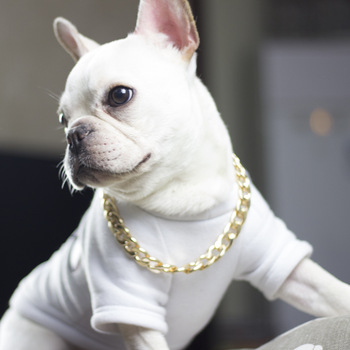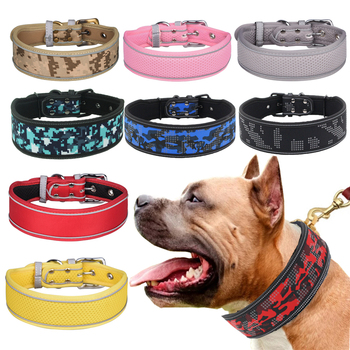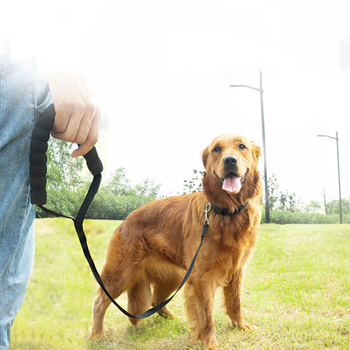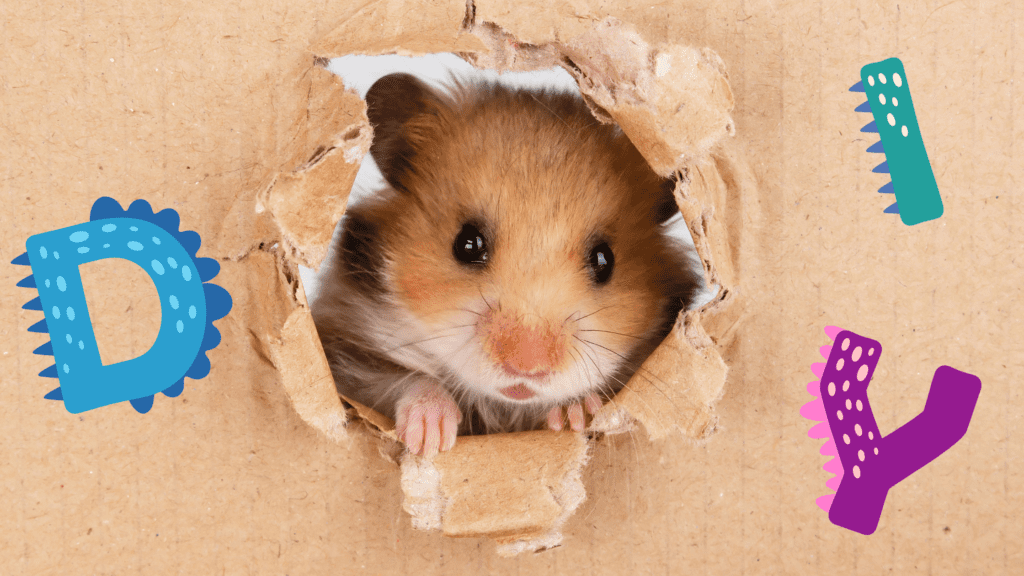As a dog owner, choosing the right collar and leash for your furry friend is an important decision. Not only do they serve as a means of identification, but they also provide a way to safely control and manage your dog while out and about. However, with so many options available, it can be overwhelming to determine which collar and leash combination is best suited for your dog’s breed, size, and personality.
Comfort and control are two essential factors to consider when choosing a collar and leash for your dog. The right combination can help ensure that your dog is comfortable and secure, while also allowing you to maintain control in different situations.
In this article, we’ll provide a comprehensive guide on how to choose the perfect collar and leash for any dog breed. Whether you have a small lap dog or a large working breed, we’ll cover the factors to consider, different types of collars and leashes available, and how to use them effectively. By the end of this article, you’ll have the knowledge you need to make an informed decision and keep your furry companion happy, comfortable, and safe.
Understanding Dog Breeds

Different dog breeds have unique physical and behavioral characteristics that can impact the type of collar and leash that is best suited for them. For example, a small breed like a Chihuahua may require a lighter collar and leash than a large breed like a Great Dane, and a breed with a thick coat like a Husky may require a collar that won’t mat their fur. Additionally, certain breeds may have a higher prey drive or be prone to pulling, which can affect the type of collar and leash you choose.
When selecting a collar and leash for a specific breed, it’s important to consider their individual needs and characteristics. This includes their size, coat type, activity level, and personality. For example, a breed that is prone to pulling may benefit from a no-pull harness or a martingale collar, while a breed with a thick coat may need a collar that won’t match their fur.
By understanding the unique characteristics of different dog breeds and considering these factors when selecting a collar and leash, you can ensure that your furry friend is comfortable, safe, and secure during walks and other activities. In the following sections, we’ll explore different types of collars and leashes and how they can be used for specific breeds.
Types of Collars
There are several types of collars available for dogs, each with its own unique benefits and drawbacks. The most common types of dog collars include flat collars, martingale collars, choke collars, and prong collars.






Flat Collars
Flat collars are the most basic and widely used type of dog collar. They are made of a simple strip of material, such as nylon or leather, with a buckle or snap closure. Flat collars are typically used for identification purposes and leash attachment.
One of the main benefits of flat collars is their simplicity and affordability. They are also lightweight and comfortable for most dogs to wear. Flat collars are appropriate for most breeds and situations, such as daily walks or trips to the vet.
When choosing a flat collar, it’s important to select the right size and material. The collar should fit snugly but not be too tight, and the material should be durable and easy to clean.
Martingale Collars
Martingale collars, also known as limited-slip collars, are designed to provide more control than flat collars without the potential choking hazard of a choke chain. They consist of a flat collar with a loop of material that tightens when the dog pulls or tries to back out of the collar.
Martingale collars are often recommended for breeds with narrow heads, such as Greyhounds, as they can prevent the dog from slipping out of the collar. They are also useful for training purposes or for dogs who tend to pull on the leash.
When choosing a martingale collar, it’s important to select the right size and material. The collar should fit snugly around the dog’s neck when the loop is pulled tight, but should not be too tight or restrictive.
Choke Collars
Choke collars, also known as slip collars, consist of a chain or fabric loop that tightens around the dog’s neck when pulled. They are often used for training purposes or for dogs who are difficult to control on walks.
One of the main benefits of choke collars is their ability to quickly and effectively communicate with the dog. However, they can also cause injury or discomfort if used incorrectly, and should only be used under the guidance of a professional trainer.
When choosing a choke collar, it’s important to select the right size and material. The collar should fit snugly around the dog’s neck without being too tight, and the material should be strong and durable.
Prong Collars
Prong collars, also known as pinch collars, consist of a series of metal links with prongs that pinch the dog’s neck when pulled. They are often used for training purposes or for dogs who are difficult to control on walks.
One of the main benefits of prong collars is their ability to quickly and effectively communicate with the dog. However, they can also cause injury or discomfort if used incorrectly, and should only be used under the guidance of a professional trainer.
When choosing a prong collar, it’s important to select the right size and material. The collar should fit snugly around the dog’s neck without being too tight, and the prongs should be rounded and not sharp.
Types of Leashes
In addition to collars, choosing the right leash for your dog is also important for their comfort and safety. There are several types of leashes available, each with its own unique benefits and drawbacks. The most common types of dog leashes include standard leashes, retractable leashes, and adjustable leashes.






Standard Leashes
Standard leashes, also known as fixed-length leashes, are the most basic type of leash. They consist of a single length of material, such as nylon or leather, with a clip at one end for attachment to the collar and a handle at the other end for the owner to hold.
One of the main benefits of standard leashes is their simplicity and affordability. They are also lightweight and easy to use. Standard leashes are appropriate for most breeds and situations, such as daily walks or obedience training.
When choosing a standard leash, it’s important to select the right length and material. The length should be appropriate for the size of your dog and the environment you will be walking in, and the material should be durable and comfortable for both you and your dog.
Retractable Leashes
Retractable leashes consist of a thin cord or ribbon that is wound around a spring-loaded mechanism inside a plastic handle. The length of the leash can be adjusted and locked in place, allowing the dog to walk further away from the owner.
One of the main benefits of retractable leashes is the additional freedom of movement they provide for the dog. However, they can also pose safety risks if the dog wanders too far or if the cord becomes tangled or twisted.
When choosing a retractable leash, it’s important to select the right length and material. The length should be appropriate for the size of your dog and the environment you will be walking in, and the material should be strong enough to handle the weight and strength of your dog.
Adjustable Leashes
Adjustable leashes, also known as multi-functional leashes, consist of a single length of material with multiple rings or clips that can be adjusted to create different lengths and configurations.
One of the main benefits of adjustable leashes is their versatility and adaptability to different situations. They can be used for walking, running, training, and even as a temporary tie-out.
When choosing an adjustable leash, it’s important to select the right length and material. The length should be appropriate for the size of your dog and the environment you will be using it in, and the material should be strong and durable enough to handle different configurations.
Collar and Leash Safety
Collars and leashes play an important role in keeping dogs safe and under control, but they can also pose potential hazards if not used properly. It’s important for dog owners to be aware of these risks and take steps to prevent accidents and ensure safety.
Potential hazards associated with collars and leashes include:
- Choking or strangulation if the collar or leash becomes tangled or caught on an object
- Injury or skin irritation from a poorly fitting collar or leash
- Escaping or slipping out of a collar or leash if it’s not properly secured
- Aggravating existing medical conditions, such as neck injuries or respiratory problems
To prevent accidents and ensure safety, dog owners can follow these tips:
- Choose the right size and type of collar and leash for your dog’s breed and size
- Ensure the collar and leash fit properly and are adjusted to the right length
- Regularly check the collar and leash for signs of wear or damage and replace as needed
- Use a harness or head halter instead of a collar for dogs with respiratory or neck issues
- Always supervise your dog when using a collar and leash, and never leave them unattended while tethered
- Train your dog to walk calmly on a leash and avoid pulling or lunging
- Avoid using choke, prong, or shock collars, as they can cause pain and injury to dogs
By following these safety tips, dog owners can help ensure that collars and leashes are used in a safe and responsible way, while also providing comfort and control for their furry companions.
Training with Collars and Leashes
Proper training is essential for dogs to feel comfortable wearing a collar and using a leash. Without it, dogs may become fearful or anxious and resist wearing a collar or walking on a leash. To ensure a positive experience for both the dog and the owner, here are some tips for training with collars and leashes:
How To Train a Dog to Wear a Aollar and Use a Leash?
- Start by introducing the collar gradually, allowing your dog to sniff and explore it before putting it on.
- Once your dog is comfortable with the collar, attach a leash and allow your dog to drag it around the house for short time periods.
- Gradually increase the length of time your dog wears the collar and leash, offering positive reinforcement in the form of treats and praise.
- Practice walking with your dog on a leash in a quiet, distraction-free area before gradually increasing the level of difficulty.
How to Address Common Training Issues?
- If your dog pulls or lunges on the leash, try stopping and standing still until your dog returns to your side, then reward with treats and praise.
- If your dog resists wearing a collar or leash, try offering treats or toys as positive reinforcement, or using a harness instead of a collar.
- If your dog becomes anxious or fearful, try reducing the level of distraction and offering plenty of positive reinforcement.
Tips for Positive Reinforcement Training Techniques
- Use treats, praise, and toys as rewards for good behavior.
- Keep training sessions short and consistent to avoid overwhelming your dog.
- Avoid using punishment or negative reinforcement, which can lead to fear and anxiety.
By following these tips and using positive reinforcement techniques, dog owners can help their furry companions feel comfortable and confident wearing a collar and using a leash, making walks and outings a more enjoyable experience for everyone.
Conclusion
Selecting the right collar and leash for your dog breed is essential for comfort and control during walks and outings. By understanding the unique characteristics of different dog breeds and the pros and cons of various types of collars and leashes, owners can make informed decisions that ensure their dog’s safety and well-being.
Key takeaways from this article include the importance of collar and leash safety, the different types of collars and leashes available, and the benefits of positive reinforcement training techniques. It is recommended to choose a collar and leash that suits your dog’s breed and personality, taking into account factors such as size, strength, and energy level.
Remember to always prioritize your dog’s comfort and safety when selecting a collar and leash, and to practice positive reinforcement techniques for effective training. With the right collar and leash, your furry companion will enjoy many happy and comfortable walks for years to come.
Say goodbye to boring pet names! Let our Pet Name Generator give your new pal a name they’ll love.
Frequently Asked Questions
What type of collar is best for a small dog?
A flat collar or a harness is typically the best option for small dogs, as they provide comfort and control without putting too much pressure on the dog’s neck.
How do I measure my dog’s neck for a collar?
Use a tape measure to measure the circumference of your dog’s neck, and add two inches to get the correct collar size.
What type of leash is best for a strong dog?
A sturdy, non-retractable leash made of durable materials, such as leather or nylon, is best for strong dogs.
How do I train my dog to walk on a leash without pulling?
Use positive reinforcement techniques, such as rewarding your dog for walking beside you and stopping when they pull, and gradually increasing the duration and distance of walks.
Can a collar or leash cause injury to my dog?
Yes, improper use of a collar or leash can cause injury to a dog’s neck or throat, so it’s important to choose the right size and type of collar or leash and to use them correctly.
How often should I replace my dog’s collar or leash?
It’s recommended to replace collars and leashes every six months to a year, or sooner if they show signs of wear and tear.
Can I use a cat collar on a small dog?
No, cat collars are not designed to withstand the strength and activity level of a dog and may cause injury.
What should I do if my dog refuses to wear a collar or use a leash?
Gradually introduce the collar or leash and use positive reinforcement techniques to encourage acceptance. Seek professional help if necessary.
Can I leave a collar on my dog at all times?
It’s not recommended to leave a collar on a dog at all times, as it can cause irritation or injury. Only use a collar during walks or outings.
What are the benefits of using a harness instead of a collar?A harness can provide better control and comfort, distribute pressure evenly across the dog’s body, and prevent injury to the neck or throat.





